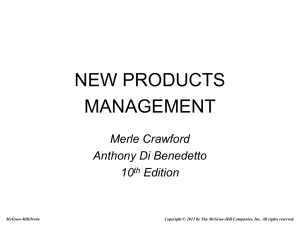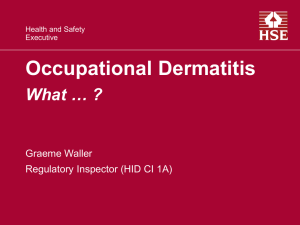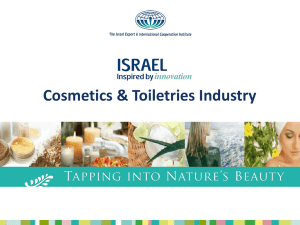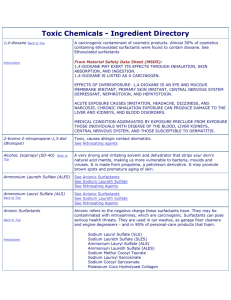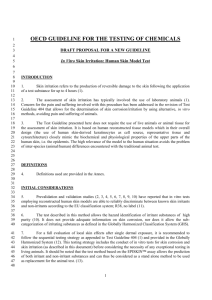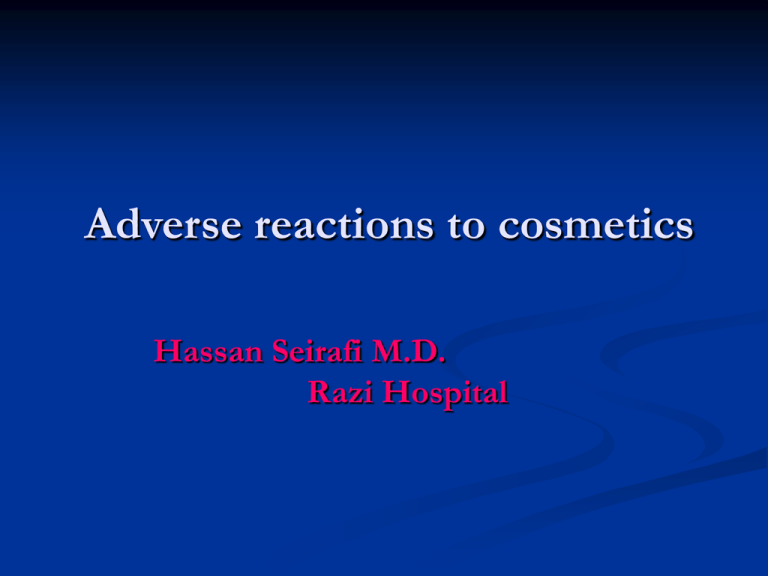
Adverse reactions to cosmetics
Hassan Seirafi M.D.
Razi Hospital
Cosmetics
Objective irritation
Subjective irritation
Acute or corrosive
Irritant dermatitis
Cumulative Irritation
Mechanical irritation
Objective irritation
Phototoxic reaction
Pustular eruption
Acneiform eruption
Subjective irritation
Sensory irritation
Burning
Stinging
Itching
Prickling
Tingling
Allergic contact dermatitis
Cosmetics
A relation to cosmetics was suspected by the
dermatologist or patient initially in fewer than
half of the cases.
Incidance:
Site:
Sex:
5%
59% in Face
79% in Women
Allergic contact dermatitis to
cosmetics
Colophony
Fragrance mix
Paraphenylendiamine
Lanolin alcohol (Wool alcohol)
Quaterium-15
Formaldehyde
Balsam of peru
Paraben mix
Thimerosal
Cosmetics
Not safely applied in closed patch tests
Shampoo
Soaps
Detergent
Hair bleach
Mascara
Nail polish
Depilatories
Bleaching cream
Hair dyes
Hair spray
Perfumes
Nail polish removers
Allergic contact dermatitis to
cosmetics
Tests for Dignosis
Thin-layer rapid use epicutaneous test (T.R.U.E)
Repeat open application test (ROAT)
Fragrances
Fragrance allergy
Incidence:
1%
Sites
Face, Neck, Hands, Axillae or Generalized
Fragrance mix: 86% Positive
Test
Allergy to fragrances and coal tar dyes
Epidemics of bizarre facial pigmentation in Japanese
women (1960-1970)
Sensitive skin
Cosmetic intolerance syndrome
Facial burning & discomfort with application of most
skin care products
Overt inflammatory changes or only subjective
symptoms
Over the past two decades, most of these individuals
have been recognized to have organic basis rather than
a functional basis for their complaints
Causes of facial skin intolerance to
cosmetics
Exogenous:
Subjective irritation
Objective irritation
Contact urticaria
Allergic contact dermatitis
Photo allergic contact
dermatitis
Endogenous:
Seborrhea/Seborrheic
dermatitis
Psoriasis
Rosacea/Perioral
dermatitis
Atopic dermatitis
Dysmophobia
Contact urticaria
Non immunologic:
Benzoic acid
Cinnamic acid
Cinnamal
Immunologic:
Methyl paraben
Henna
Ammonium
persulfate
Preservatives
Approximately 60 chemicals are commonly used in
cosmetics
Parabens rarely sensitize but may do so when applied to
eczematous skin
Propylen glycol is a mild irritant, occasionally sensitizes
Formaldehyde may sensitize
Tocopherol and t-butyl hydroquinone as antioxidants
may sensitize
UV light-absorbing agent
Lanolin
Moisturizers
The mechanism of action and biology are
highly complex
Petrolatum is not a primary or cumulative irritant & can
protect against irritant effects of detergents
Lanolin is esthetically acceptable & is allergenic in 2 %
to 5%
Cholesterol & Free fatty acids & Ceramides are being
used to formulate moisturizers
Diagnosis & Treatment
Examine every cosmetics & skin care product
Administer patch and photo patch test to rule out occult allergic
and photo allergic dermatitis
Test for contact urticaria
Do careful repeat open application testing (ROAT)
Treat endogenous inflammatory disease
Do not use soap or detergent
Lip cosmetics as desired if lips are clear
Eye cosmetics if eyelids are asymptomatic
Face powder if necessary
Glycerin & rose water as a moisturizer if necessary
Avoiding other cosmetics for 6 to 12 months


